Ceiling fans make you feel cooler by increasing air circulation, which helps sweat evaporate from your skin faster, removing heat and boosting comfort—even if the room’s temperature stays the same. Air conditioners actually lower the room temperature by removing heat and humidity. Humidity affects how effective evaporation feels; dry air promotes cooling, while humid air traps moisture. Understanding these physics clues will help you choose the best option—exploring further reveals how to optimize comfort and save energy.
Key Takeaways
- Fans increase perceived cooling by enhancing airflow and sweat evaporation without lowering room temperature.
- Air conditioners actively reduce ambient temperature and humidity, providing actual cooling.
- Fans are energy-efficient, consuming less power, and are cost-effective for maintaining comfort.
- ACs improve comfort by removing heat and moisture, especially in high humidity conditions.
- Combining fans with ACs optimizes cooling effectiveness and energy use, leveraging physics of airflow and evaporation.
How Air Circulation Affects Perceived Temperature
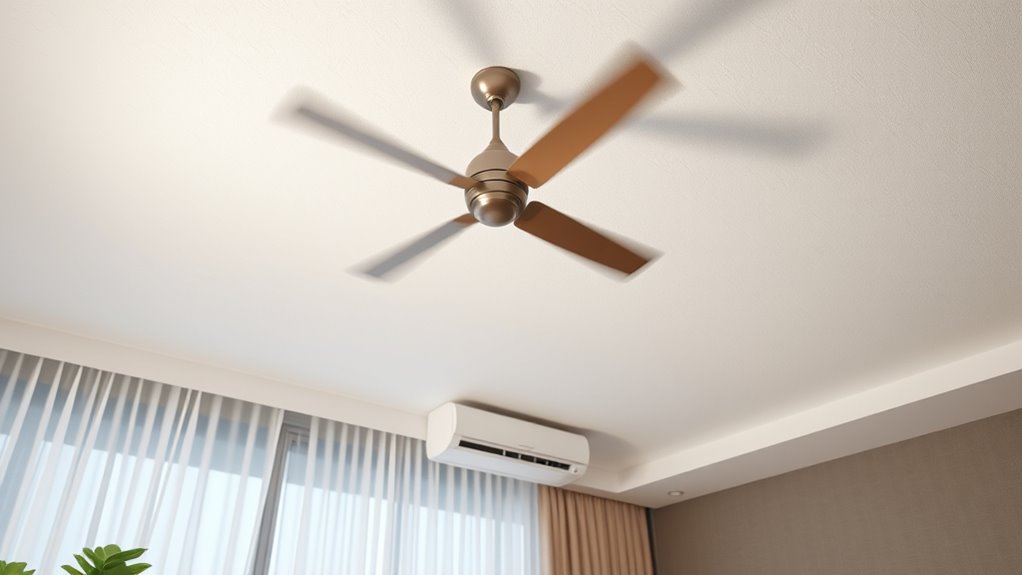
Air circulation plays an essential role in how cool you feel, regardless of the actual temperature. Proper airflow patterns can make a room feel considerably cooler by moving air across your skin, enhancing the evaporation of sweat. Fan placement is key—positioning fans near windows or doorways can optimize airflow and create a steady breeze that improves comfort. When fans are strategically placed, they prevent stagnant air, which can make a space feel stuffy and warmer. You should aim for a setup that directs air toward you without creating drafts. This ensures consistent circulation and a more pleasant environment. Understanding how airflow patterns work and adjusting fan placement accordingly can maximize perceived coolness without lowering the thermostat. Additionally, leveraging smart‑home integrations can help automate and optimize fan operation for even better comfort. Proper air exchange also helps maintain indoor air quality, further enhancing overall comfort during warmer days. Effective airflow management is supported by the principles of air circulation, which involve the movement of air to prevent hot spots and promote uniform cooling. Incorporating ventilation strategies can further enhance the cooling effect by reducing stale air buildup and improving overall air movement. Recognizing the importance of humidity control is also essential, as lower humidity levels can significantly increase comfort by aiding sweat evaporation.
The Role of Evaporation in Cooling the Body
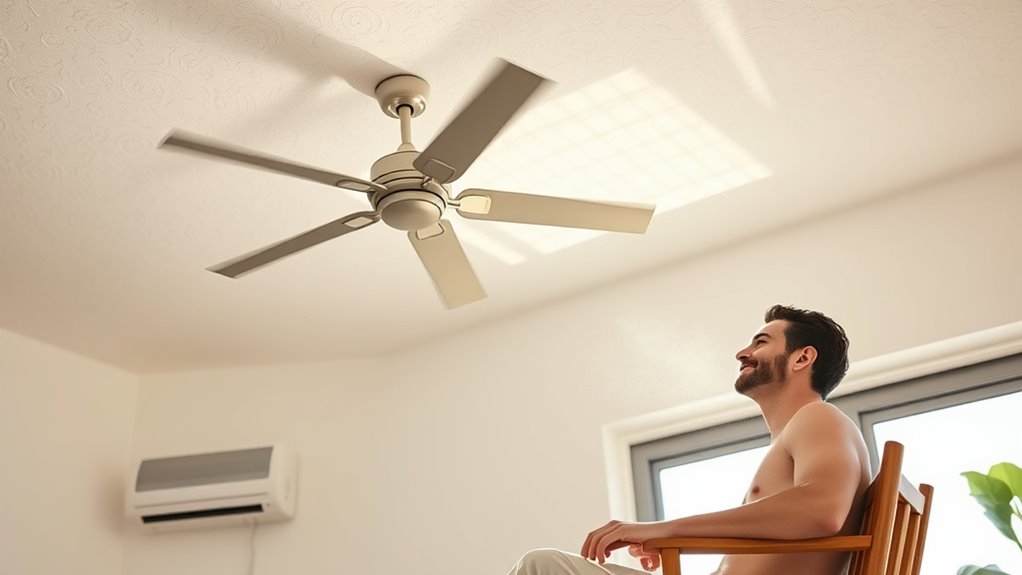
When your sweat evaporates from your skin, it takes heat away and helps cool your body. The speed of evaporation depends on factors like humidity, airflow, and temperature. Understanding these environmental impacts can help you stay comfortable in different conditions. Additionally, proper skincare can support the skin’s natural cooling process and maintain its health. Using eye patches with soothing ingredients can also help reduce skin irritation caused by environmental stressors. Incorporating knowledge of adaptive learning technologies can further optimize personal comfort strategies based on individual responses to temperature and humidity changes. Developing strong communication skills can also assist in sharing your comfort needs and strategies effectively with others. Moreover, engaging with music therapy techniques can promote relaxation and reduce stress, complementing physical cooling methods.
Sweat Evaporation Mechanics
Sweat evaporation is an essential process that helps cool your body during heat exposure. When your sweat evaporates from your skin, it absorbs heat from your body, facilitating heat transfer away from your core. The efficiency of this cooling depends on the thermal conductivity of your skin and sweat, which determines how effectively heat moves from your body to the sweat. As sweat turns into vapor, it takes heat with it, lowering your internal temperature. Factors like humidity can slow this process by reducing evaporation, but the basic mechanics remain the same. Additionally, the rate of evaporation is influenced by the thermal conductivity of your skin and sweat, which plays a key role in how quickly heat is transferred away from your body. The thermal properties of your skin and sweat also impact the overall efficiency of heat transfer during evaporation. Understanding these thermal dynamics can help you optimize passive cooling methods like ceiling fans or air conditioning to support your body’s natural cooling process. Moreover, airflow around the skin can significantly enhance evaporation rates by removing the humid air layer close to the skin, thus aiding in cooling.
Environmental Impact Factors
Environmental factors substantially influence how effectively your body can cool itself through evaporation. Humidity levels, air circulation, and temperature determine how quickly sweat evaporates from your skin. When the air is dry and moving, evaporation occurs faster, helping you feel cooler. Using ceiling fans powered by renewable energy reduces your carbon footprint, making cooling more environmentally friendly. Additionally, choosing appliances made from recyclable materials minimizes waste and environmental harm. Proper ventilation techniques can significantly improve the efficiency of natural cooling methods. By understanding these factors, you can optimize your cooling methods to be both effective and sustainable. Incorporating natural ventilation and energy-efficient devices supports your comfort while reducing environmental impact. Moreover, energy-efficient devices can further enhance the overall sustainability of your cooling strategies, minimizing resource consumption and waste. Paying attention to humidity control can also help maintain a more comfortable indoor environment and improve evaporation efficiency. Utilizing sustainable materials in your cooling appliances can further reduce environmental impact and promote eco-friendly practices.
Differences in Cooling Mechanisms: Fans vs. Air Conditioners

Fans and air conditioners achieve cooling through fundamentally different mechanisms. Fans work by creating airflow patterns that increase evaporation of sweat from your skin, making you feel cooler even if the air temperature remains unchanged. They don’t lower the room temperature but enhance your comfort through movement and airflow. In contrast, air conditioners actively remove heat from the air via a cooling cycle, lowering the ambient temperature directly. The cooling cycle involves refrigerants absorbing heat and releasing it outside, which results in a noticeable drop in room temperature. While fans rely on airflow to improve comfort, air conditioners change the actual thermal environment. Additionally, automation in business has influenced the development of more advanced and efficient cooling technologies. Understanding these differences helps you choose the right device based on whether your priority is direct temperature reduction or personal comfort through airflow. Moreover, advancements in HVAC technology have led to energy-efficient models that can better meet modern needs while reducing costs. Incorporating smart cooling systems can further optimize energy use and enhance user comfort with automated adjustments. As the demand for energy-efficient solutions increases, the integration of renewable energy sources into cooling systems is also becoming more prevalent. Innovations in environmentally friendly refrigerants are also contributing to more sustainable cooling options.
The Impact of Humidity on Comfort Levels
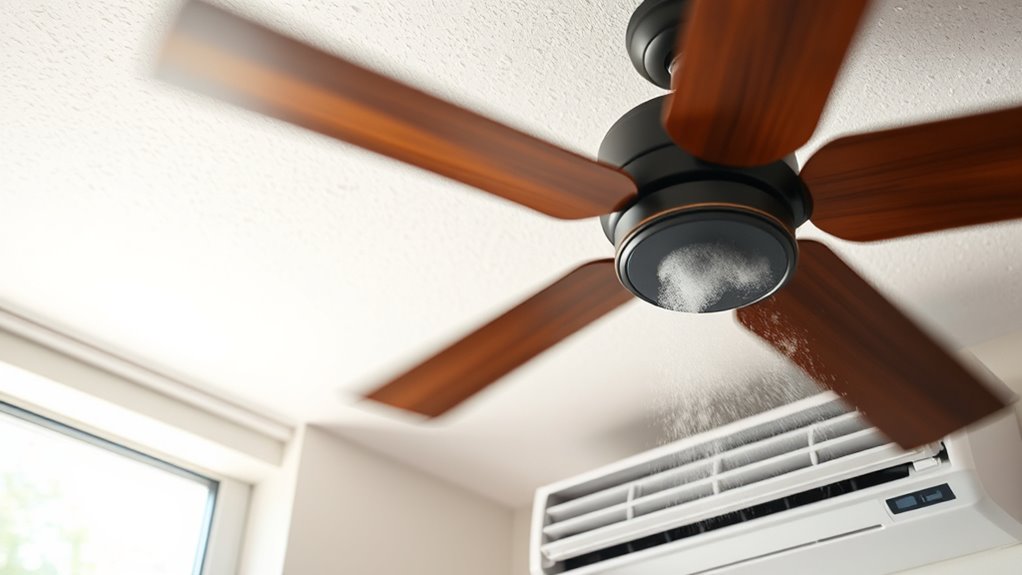
While air conditioners can lower both temperature and humidity levels, fans primarily influence how comfortable you feel by moving air across your skin. Humidity effects play a vital role in comfort modulation because high humidity traps moisture on your skin, making you feel hotter even if the temperature drops. Conversely, low humidity allows sweat to evaporate more easily, enhancing cooling. When humidity rises, your body struggles to cool itself, leading to discomfort and fatigue. You might experience:
- Sticky, clammy skin that feels worse with fans
- Feeling overheated despite a moderate temperature
- Reduced effectiveness of fans in humid conditions
- An overall sense of sluggishness and discomfort
Understanding humidity’s impact helps you choose the right cooling method to feel genuinely cooler and more comfortable. Additionally, humidity control can significantly improve overall comfort in your environment.
Energy Efficiency and Cost Considerations

When comparing operating costs, ceiling fans typically use less energy than air conditioners, which can lead to significant savings over time. You might notice that fans are cheaper to run daily, especially in moderate temperatures. Considering long-term expenses, choosing the right option could make a big difference in your overall energy bills.
Operating Costs Comparison
Understanding the operating costs of ceiling fans and air conditioners is essential for making an informed decision. When comparing cost and energy expenses, ceiling fans generally cost less to run, making them more affordable for everyday use. An air conditioner, however, consumes considerably more energy, leading to higher utility bills. Consider these points:
- Ceiling fans use a fraction of the energy needed for ACs, reducing your energy expenses.
- Running a fan costs only a few cents per hour, while ACs can run much higher.
- Fans are ideal for immediate, localized cooling without driving up your electricity bill.
- Air conditioners provide powerful cooling but at a greater long-term financial cost.
Choosing between them depends on your budget and cooling needs, but energy efficiency plays a key role in the cost comparison.
Long-term Savings Potential
Considering the significant difference in operating costs, evaluating the long-term savings potential of ceiling fans versus air conditioners becomes important. Ceiling fans generally have lower energy consumption, which means you’ll spend less on electricity over time. Although installation costs for ceiling fans are typically lower than those for air conditioners, their savings depend on usage. Air conditioners, while more expensive upfront, can cool larger spaces more efficiently, but their high energy consumption adds up. If you’re looking for cost-effective cooling, ceiling fans offer a better long-term option, especially in moderate climates. By reducing your reliance on air conditioning, you’ll see noticeable savings on your energy bills. Keep in mind that the efficiency of each option depends on your specific needs and home environment.
When to Choose a Ceiling Fan Over an Air Conditioner
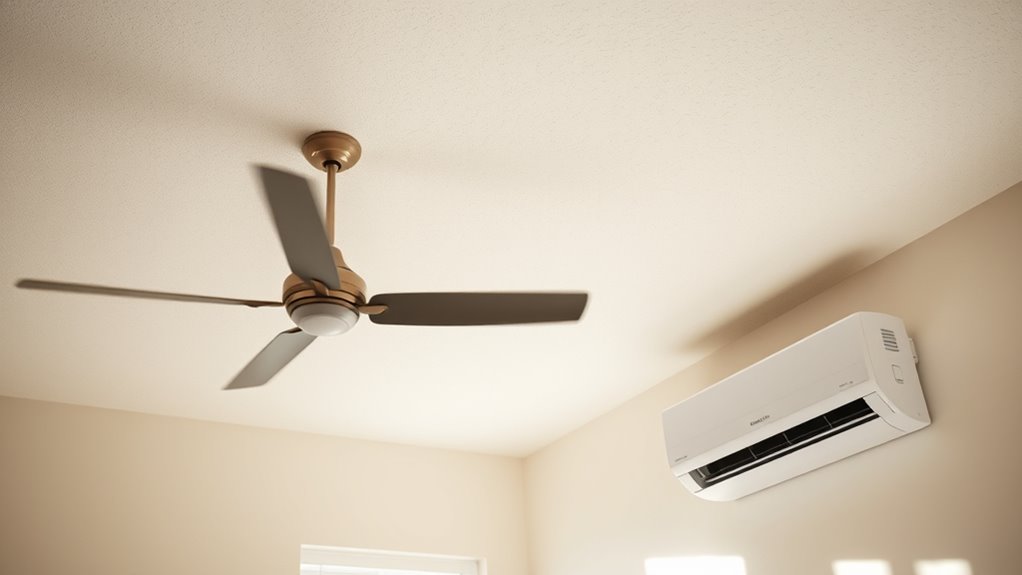
Choosing a ceiling fan over an air conditioner makes sense when you want to circulate air efficiently without considerably increasing your energy bill. Fans improve air quality by reducing stagnant, stale air and creating a invigorating breeze. They also operate quietly, so noise levels won’t disturb your relaxation or sleep. Consider a ceiling fan if you prefer a natural cooling effect and want to avoid the higher energy costs of AC.
Think about these benefits:
- Enhances air quality with better air circulation
- Maintains a peaceful, quiet environment
- Offers affordable, energy-efficient cooling
- Creates a comfortable atmosphere without heavy noise
Opt for a ceiling fan when your space needs consistent airflow, especially in mild weather or smaller rooms, and when air quality and low noise are priorities.
Optimal Use of Fans and AC for Maximum Comfort
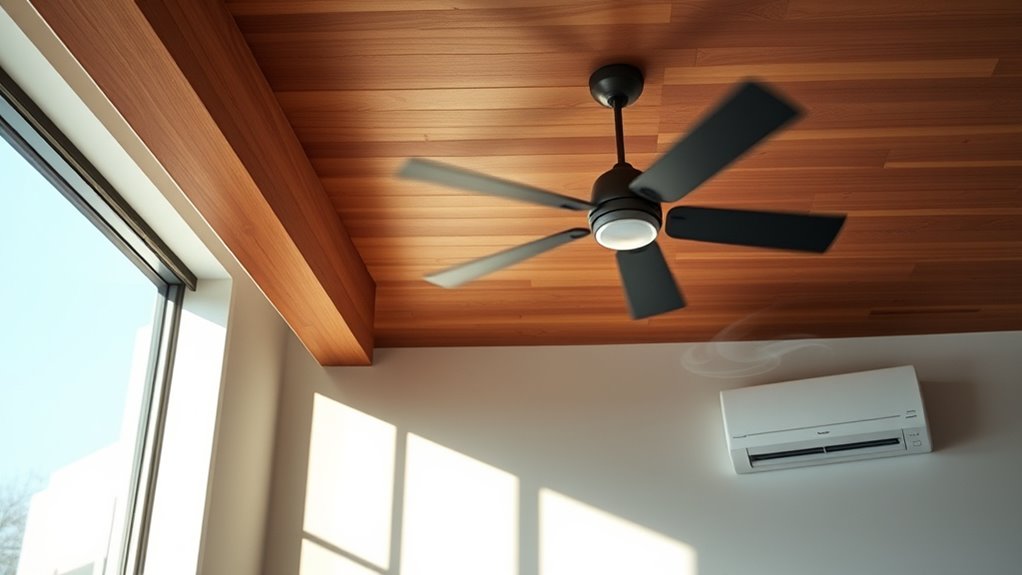
To maximize comfort, it’s important to use fans and air conditioning together strategically, rather than relying on just one. Fans circulate air, enhancing airflow and reducing perceived temperature, while AC cools the space directly. To optimize their combined use, consider the following:
| Fan Usage | AC Settings |
|---|---|
| Keep fans on low to avoid noise distractions | Set AC to a comfortable, energy-efficient temperature |
| Use fans to improve air circulation, promoting air quality | Use timers or programmable thermostats to prevent overcooling |
| Position fans to direct airflow away from occupants | Maintain good air filtration to ensure air quality remains high |
This approach reduces noise levels, improves air quality, and keeps your environment comfortably cool.
Environmental Implications of Cooling Choices

Using fans and air conditioning impacts the environment in several ways. AC units consume significant electricity, often generated from fossil fuels, which inflames climate change. They also release greenhouse gases, contributing to global warming. Fans, though more energy-efficient, still use electricity that may come from non-renewable sources. Your cooling choices influence indoor air quality, with air conditioning sometimes reducing fresh air circulation and increasing indoor pollutants. Conversely, fans promote better airflow, improving air quality and reducing reliance on energy-intensive systems.
Cooling choices like fans and AC affect climate change and indoor air quality significantly.
- Dependence on fossil fuels accelerates climate change
- Increased greenhouse gas emissions harm future generations
- Limited use of renewable energy hampers eco-friendly cooling
- Indoor air quality suffers with certain cooling methods
Your choices shape a sustainable future and healthier living environment.
Frequently Asked Questions
How Does Room Size Influence the Effectiveness of Fans Versus Air Conditioning?
Room size critically influences how well fans or air conditioning work. In larger spaces, a fan’s coverage might be insufficient to circulate air evenly, making it less effective. Conversely, air conditioning can better regulate temperature across the entire room, regardless of volume. If your room is small, a fan can be quite effective, but for bigger rooms, an AC unit ensures consistent cooling. Choose based on your room’s volume for ideal comfort.
Can Ceiling Fans Help Reduce Energy Costs in a Home?
They say “a penny saved is a penny earned,” and ceiling fans can indeed help cut your energy costs. By improving air circulation, fans make you feel cooler without cranking up the AC, leading to significant energy savings. This results in cost benefits over time, especially if you use fans consistently. While fans don’t replace AC, they’re an efficient way to stay comfortable and save money in the long run.
Does Ceiling Fan Use Impact Indoor Air Quality?
Yes, ceiling fan use can influence indoor air quality by improving air circulation. As you turn on a ceiling fan, it enhances ventilation effectiveness, helping to disperse indoor pollutants and reduce stuffiness. This continuous air movement prevents stagnation, which can minimize odors and airborne allergens. Keep in mind, however, that fans don’t filter air, so combining them with proper ventilation or air purifiers ensures better indoor air quality overall.
Are There Health Risks Associated With Prolonged Use of Air Conditioners?
Did you know that prolonged air conditioner use can reduce indoor air quality and pose health risks? You might experience dry skin, respiratory issues, or allergies due to lowered humidity and circulating allergens. While ACs keep you cool, extended use can lead to discomfort or health problems, especially if filters aren’t maintained. To stay safe, guarantee proper maintenance and take breaks from continuous AC use to improve air quality and reduce health risks.
How Do Outdoor Temperature Changes Affect Indoor Cooling Strategies?
Outdoor temperature changes considerably impact your indoor cooling strategies. When it’s hotter outside, you should enhance thermal insulation to keep the heat out and improve humidity control to prevent moisture buildup. During cooler days, open windows for natural ventilation and reduce reliance on AC. Adjusting these strategies helps maintain a comfortable indoor environment, saving energy and reducing costs while ensuring you stay cool regardless of outdoor temperature fluctuations.
Conclusion
Choosing between a ceiling fan and an AC is like picking between a gentle breeze and a rushing river—you feel the difference in your bones. Fans glide softly, stirring air like whispers of comfort, while ACs sweep away heat with relentless force. Your choice shapes not just your comfort, but the world around you. Embrace the dance of physics, and let your cooling method be the song that keeps you cool, calm, and collected.









